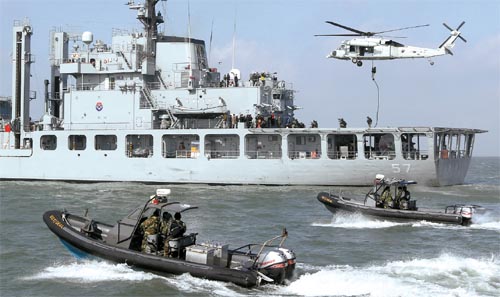Tech, quick wits, helped rescue ship

Korean UDT/SEAL commandos stage an operation in an anti-terrorism drill on Saturday in the Yellow Sea, near the Navy’s 2nd Fleet Headquarters in Pyeongtaek, Gyeonggi. The commandos used high-speed rubber boats and UH-60 helicopters to combat mock pirates hijacking a ship. [YONHAP]
State-of-the-art surveillance technology used by the Korean military contributed to the successful rescue of the Samho Jewelry and its crew, military officials said yesterday.
The officials also credited the Navy special forces’ rigorous discipline, in addition to cooperation from allied forces and the wits of the pirated ship’s captain.
Thursday’s rescue operation, which ended the Somali pirates’ week-long seizure of the Korean chemical carrier, was a big boost for a military bitterly criticized for lax responses to last year’s attacks from North Korea. All of the Samho Jewelry’s 21 crew members, including eight Koreans, were rescued alive. The ship’s captain, Seok Hae-gyun, sustained a gunshot wound to the stomach, but is not in life-threatening condition. Three special forces soldiers were wounded. Eight pirates were killed in the rescue, and five others captured.
According to officials at the Ministry of National Defense, state-of-the-art monitoring systems helped military commanders in Seoul deliver swift commands to the rescuers. Navy special forces mobilized in the operation wore wireless video and audio recording systems - called Kaishot - on their helmets and could transmit real-time information about the pirates’ moves to commanders in Seoul, the officials said.
A Long Range Acoustic Device (LRAD) on the destroyer Choi Young also helped reduce the number of casualties because the Navy could tell the captured Korean crew members where to position themselves safely during the operation, the officials said. The LRAD is a relatively new technology sometimes used in cities to disperse protestors.
Two pirates surrendered via the communication system.
“High-tech electronic device are proving to be increasingly useful in this kind of mission,” said a government official. Government agencies are considering requiring Korean ships to install more electronic surveillance devices, he said.
About 20 Navy special forces called UDT (Underwater Demolition Team) were mobilized to rescue the crew during the operation. According to those familiar with piracy off the eastern coast of Africa, scores of rescue operations get attempted near the Gulf of Aden every year, but it is rare for all the hostages to be rescued safely.
“Called a human arsenal, UDT members are selected through a 24-week basic training process, the longest such process in all Korean military branches, as well as a special training program measuring abilities like diving, bomb-planting, information-gathering and man-to-man combat,” said a military official.
The officials said that in order to enhance precision, UDTs practice shooting 10 times a month.
Cho Young-joo, the commander of the Choi Young, said in a joint telephone interview with reporters that another tactic to disorient the pirates also worked in the operation.
“Three days before we went into the final operation, we implemented training in which the Choi Young, Lynx helicopter and speedboat attempted to close in on the ship. That’s how we could catch the pirates off guard when we started the real operation,” he said.
Seok, the Samho Jewelry’s captain, also helped the operation by fooling the pirates, communicating with Korean commanders without their knowledge and slowing down the ship, the officials said.
Seok told the pirates that the ship had run out of food, and to make them believe it, he fasted for almost six days. He didn’t tell them where the food was stored.
“According to telephone records, the pirates said they were having difficulty because of hunger,” said a government official.
The lack of nourishment, and sleep shortage, weakened the pirates’ ability to repel the rescue operation, the official said. When the pirates ordered Seok to call Samho Shipping - the owner of the captured ship - to negotiate a ransom, he took advantage of the pirates’ ignorance of Korean to keep the company and the military informed of conditions on the ship.
Allied forces also provided help.
The commander of the Choi Young said allied forces provided information, sent a P-3 surveillance aircraft and helped evacuate the wounded. Korea has security agreements with 17 countries that have a total of 30 ships that can be called on for rescue operations against pirates.
“There’s a great deal of cooperation among countries, and I think this is just an example of that,” said U.S. Assistant Secretary of Ctate Philip Crowley, during a media briefing on Friday, referring to the coordinated operation to rescue the Samho Jewelry.
By Moon Gwang-lip [joe@joongang.co.kr]
Related Korean Article [중앙일보]
재밍으로 통신 먹통 만들어 해적 무력화 … 전자전의 승리
퍼펙트 작전 ‘IT 국군’
해적에게 납치된 삼호주얼리호를 구출하는 ‘아덴만 여명작전’이 끝난 지난 21일 9시56분(한국시간 오후 2시56분). 서울의 합동참모본부와 부산 해군 작전사령부, 계룡대 해군본부 지휘통제실에서는 동시에 환호성이 울렸다. 선원 구출작전에 투입된 해군 특수전(UDT/SEAL) 요원들이 국내 벤처기업 아이디폰이 개발한 무선 영상 전송 시스템 ‘카이샷(KAISHOT)’을 착용하고 있었기 때문이다. 카이샷은 최영함의 위성을 통해 세 본부에 수색 장면을 실시간으로 보냈다. 청해부대는 현장 침투요원의 헬멧은 물론 저격수의 총, 링스헬기에도 이 장비를 부착했다. 카이샷은 현장의 영상과 소리를 현장 사령부 역할을 한 최영함에 실시간 전송했다. 이 데이터는 인공위성을 통해 한국으로 전달됐다. 현장 대원들의 움직임과 숨소리까지 생생히 전달된 덕분에 본부에선 마치 현장에 있는 듯 기민하게 작전을 지휘할 수 있었다. 우리 군의 작전 상황이 중계된 것은 이번이 처음이다.
아덴만 여명작전은 시작부터 종료까지 첨단 전자전의 결속체였다. 인질로 잡혔던 선원과 구출팀의 피해 없이 완벽히 작전을 마친 데는 첨단 전자장비가 한몫을 한 셈이다. …
http://news.joins.com/article/248/4965248.html?ctg=










with the Korea JoongAng Daily
To write comments, please log in to one of the accounts.
Standards Board Policy (0/250자)